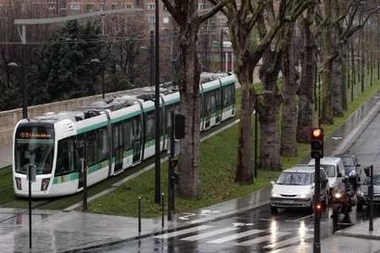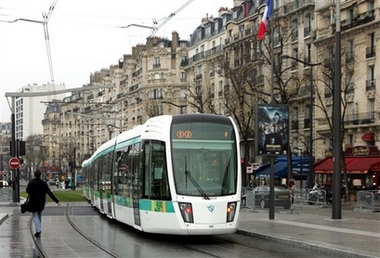Can Paris be an example for DC's Maryland suburbs?
 A tram from the new Parisian tramway is seen shortly after its inauguration in Paris, December 16, 2006. Trams returned to Paris on Saturday after a 69-year gap, with the inauguration of a new commuter service around part of the city's southern periphery. The 'Tramway of the Marshals' traces a five-mile (eight-km) arc along the southern perimeter, following a series of boulevards named after Napoleon's generals. REUTERS/Benoit Tessier (FRANCE).
A tram from the new Parisian tramway is seen shortly after its inauguration in Paris, December 16, 2006. Trams returned to Paris on Saturday after a 69-year gap, with the inauguration of a new commuter service around part of the city's southern periphery. The 'Tramway of the Marshals' traces a five-mile (eight-km) arc along the southern perimeter, following a series of boulevards named after Napoleon's generals. REUTERS/Benoit Tessier (FRANCE).Paris has just inaugurated a 5 mile long Citadis (by Alstom) light rail system on the southern border of the city. It took three years to construct. Judging by the photos, they did not attempt to install the in-ground power system still be tested in Bordeaux.
From the Agence France Press article, "Paris tram glides into action after 70 years":
The green-and-white trams will eventually loop the capital, carrying up to 100,000 passengers a day. For now, the trolleys will glide east to west through several of the city's left-bank arrondissements, replacing an overcrowded bus line...
The first tram set off at 10:35 am (0935 GMT) around the southern rim of the capital, whisking past grass and 1,000 flowering trees planted along the route. The line will eventually be tripled in length in the city's biggest transport scheme since the construction of the Paris ring road, in 1973.
"Trams are an exceptional tool for reducing the isolation of city dwellers," said Jean-Paul Huchon, the Socialist president of the Ile-de-France region, praising the swiftness of the three-year construction time.
Many Parisians also appear to approve of the 300-million-euro (400-million-dollar) line -- 63 percent according to a poll in the daily Figaro published Saturday. Still, most of those surveyed disapprove of Delanoe's traffic policy that includes shutting down some arteries to vehicles on weekends...
Still, the Paris tramway has been slammed as a waste of money by city's right-wing opposition, who mostly boycotted the opening ceremony... Beyond partisan sparring, the tramway underscores a growing French trend to reintroduce a method of transport that is faster than a bus and much cheaper to construct than an underground train line.
Several new tram systems were expanded across France in 2006 and two new lines are due to start up in the southern port city of Marseille in June, 2007. Three others run in the Paris suburbs.
At its peak, in 1925, the Paris tram network had 122 lines and 2,500 trams. The last line closed in 1937, as busses initially proved more flexible in coping with the increasing amount of motor traffic.
If your French is good, check out this survey of attitudes of Parisian citizens to the light rail system and other issues from Le Figaro. And this is the city's transit webpage on the new T3 tram line.
Can this be an augur of the Purple Line? The transit ring around the city, connecting the various ends of the subway lines?
 A car of the new Paris tramway is seen at Porte de Versailles, South of Paris. (AP Photo/Remy de la Mauviniere)
A car of the new Paris tramway is seen at Porte de Versailles, South of Paris. (AP Photo/Remy de la Mauviniere)Note the relatively "surgical" insertion of the line in the photos? Certainly a similar system could be "inserted" into Bethesda?
 Image from the Sierra Club.
Image from the Sierra Club.Index Keywords: transit



0 Comments:
Post a Comment
<< Home